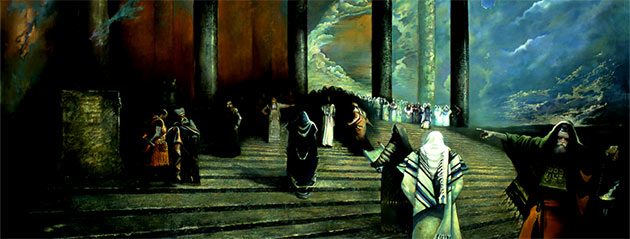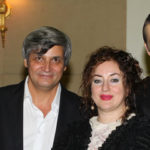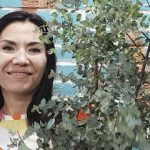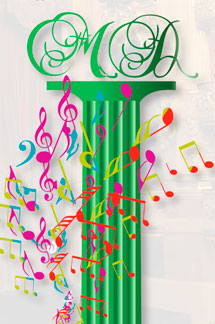This is the second hour that I am sitting on the Internet. Again I am looking at Samson. He is a nice boy: thick short hair just gaining strength, soft eyes, but in his body you feel a power. What about Delilah? Sunny day, a narrow face, long thick bangs, naughty pony tails, Cupid’s bow. I can’t see her knees but they should be injured. Who could think, looking at her, that in fifteen years she would treacherously betray Samson and would help the Philistines?
Yesterday I saw the originals. I was hooked. It’s such a strange feeling as if I were pulled out of the present and moved somewhere to eternity. It is so good to look at these pictures. It’s not joyfully, no sad. It is a strange combination of feelings… Maybe that is why I am still looking at Samson after two hours.
“In any sense I think of myself as the envoy of each image drawn by me” says the artist. He could be a rabbin with his ancient eyes and silent voice. And he draws pictures, collects and prints photos, and also leads public work. But if pictures and photos suit the image of Ghenadie his public activity does not enter the framework of my perception in any way.

Not many people in our country know Sontu. His pictures leave Moldova and travel all over the world. Paradoxes of today: for us art is a luxury, but “salute the global network that allows art to be commercial!
I like all of Ghenadie Sontu. Probably his pictures are aesthetic, even a picture of the Kishinev pogrom of 1903. Besides that they are deep and significant. I like everything, but I am looking at the children. Adam, David, Joseph, Deborah, Rebecca… Ghenadie speaks of genealogy, from our ancestors down to us. And we are all one big family, we are children in it.
 |
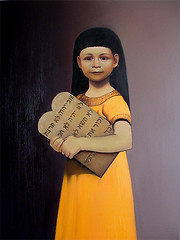 |
 |
Portraiture has lost in importance since the days when the nobility ordered their images to grace the interiors of their houses. Conceptual painting is more pleasant for the viewer because the imagination can range, even if they are actually and difficult simultaneously. You may catch an essence of the subject — or not, especially, if it is the portrait of a child. We need such aids to understanding.
But why does he draw biblical characters at such a tender age, when they have not yet done anything – neither good, not bat? Is it some kind of rehabilitation?
Sontu answers: “This rehabilitation does not give them new features. When I contemplate David, for example, I show the person. Even he is still forming. Nowadays, when people lose themselves, turned into social-political robots, such images are essential. Such images are very actual, yesterday, today and tomorrow. Up to a certain age… if you combine the personality, integrity and the heart, you can show a result. It is only possible to find a pure form of result in children.”

His boys are sad and his girls are cheeky. So it seems to others. Ghenadie smiles. It’s only impression. But “his” children are beautiful and alive, even if he takes, a few liberties; they are children who blush when they lie and who can’t deceive.
In the socio-political gallery there is a king, with two crowns, real and false. In his hands there is a violin and a spoon. The violin is a sign of intelligent people; the spoon is a symbol of the crowd. The spoon torments the fine strings. Associations rise in my mind…
“The Requiem 1903, Kishinev” is lines of empty theater seats, just seats. But it represents a scream.
There are light, touching landscapes. A red wood, a real mill on Pushkin hill, trembling birches, still-life’s, dark in appearance, but someone likes them.
It is said that his art is not modern, because it perfectly suits museums, but is not suitable for self-important offices. Museums are poor; designers of offices prefer abstracts that contrast with the office equipment. By the way, how can Samson survive near a printer?
But foreign collectors of painting are very active. It used to be very painful for him to sell a picture, but now he is accustomed to it.
Sometimes he has refused to sell a picture: “Some people think they can buy anything, from yachts to political parties. They may be right, but not concerning art. A picture enters other scale of values.”
Is there something to add to this? Only that Sontu carefully studies the buyer; he wants to be sure that his pictures are in good hands. Some Americans, Spanish have been unable to buy a picture from the Moldovan artist.
Посмотреть работы Геннадия Шонцу…
Inna Zheltova
Open Skies Magazine Nr 6(11)
December 2005

